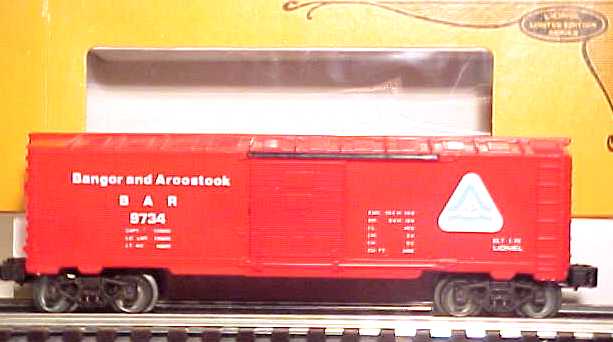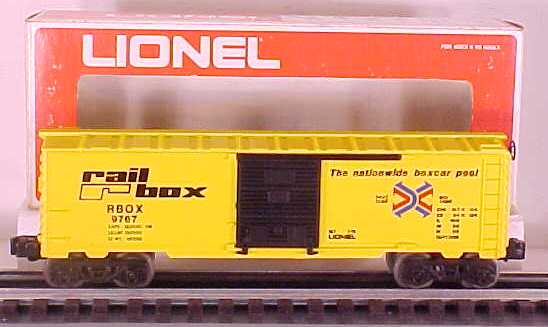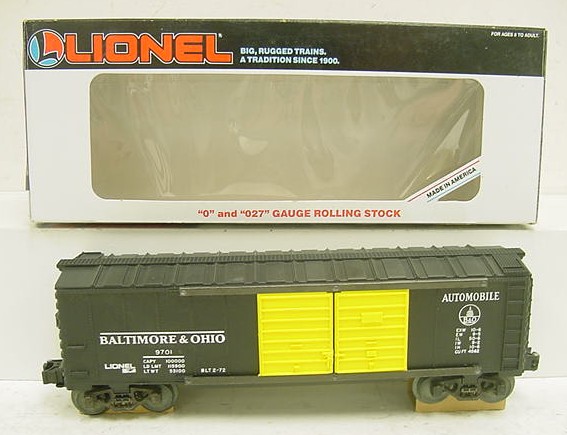The

Guide to
Lionel's 9700-Series Boxcars


When General Mills took over the production of the Lionel trains in 1970, the toy train hobby was at a low point. By the mid-1960s the Lionel line had shrunk to a shadow of its former self. Model Products Corporation, the division of General Mills charged with reviving Lionel, began searching for ways to not only make Lionels popular toys once again, but to also start tapping into the rapidly growing collector's market that began to evolve in the latter part of the 1960s.
When it took over, MPC inherited Lionel's famous 6464 boxcar series. These cars, introduced in 1953, were a mainstay of the Postwar Era until the MPC takeover. In fact, several early 6464s were reissued in 1969. When MPC took over in 1970, they introduced their own version of the 6464s, the 9200 series.
Fifteen different 9200s were produced from 1970 to 1972. In 1972, the 9200s were supplanted by a new series, the 9700s [for more on the 9200 series, click here].
The 9700s formed the backbone of Lionel's freight car line throughout the 1970s. Lionel produced the 9700s at such a fast rate that they began to run out of numbers after only six years, and in 1978 the 9700s gave over to the 9400 series. The last 9700s were catalogued in 1979, except for a straggler that was made in 1982.
Eighty-one cars make up the complete 9700 series. This article is divided into the following sections:
| Rarity, Values, and Special Notes |
| Selected Variations and Overstamped Cars |
| Boxes and Packaging |
Have fun!
|
Part 2: Relative Values and Notes about the Cars The value of the 9700 boxcars peaked in the 1990s and have dropped somewhat due to the proliferation of newer, similar cars on the market. Exact values of the cars vary, but as a general rule the series can be divided into three classes: Class 1: The largest group, this is all of the common, regularly catalogued 9700s available for separate sale. All are relatively easy to find. If the car's number is not listed in one of the two classes below, it is part of this group. Class 2: These are 9700s that were catalogued but only available in sets. They are still pretty easy to locate, but may command a slight premium. Some have die-cast trucks in place of the more common plastic design. This class includes the 9726, 9729, 9732, 9734, 9738, 9743, 9744, 9745, 9759, 9760, 9761, 9772, 9773, 9775, 9776, and 9789. Class 3: These are uncatalogued cars. Some, like the 9742, are common, but others, like the 9778, are true rarities. The uncatalogued 9700s are the 9719, 9727, 9728, 9742, 9733, 9757, 9762, 9774, 9778, 9779, and 9780. In short, the 9778 Season's Greetings, 9762 Toy Fair, and 9727 TA&G are the rarest of the 9700s, and the other cars all fall into line behind them.
|
|
Part 3: Selected Variations & Overstamped Cars Compared to their 6464 and 9200 predecessors, there are very few major variations in the 9700 series boxcars. Some of the cars have minor variants, such as slight changes in the shade of paint, but larger, more noticeable variations in cars are few and far between with the 9700s. Why is this? First, throughout the 1970s Lionel perfected painting and decorating techniques that were not available in the 1950s and 60s. New paint and decal applications meant that Lionel had better control over how the cars would ultimately come out once completed, preventing the 'trial and error' methods that caused many earlier variations. The number of cars with variations dropped dramatically beginning around 1973-74, right about the time the 9700 series was hitting its stride. The second and more important reason was shortened production runs. Whereas many 6464 boxcars were catalogued for several years and were produced several times, most 9700s were produced only one year, and often were produced in only one production run. Even cars that were catalogued for more than one year were made in one run, as the cars were re-catalogued to sell the remaining inventory. (For a fascinating look at how Lionel made trains in the 1970s, see Volume 4 of The Lionel Collector's Guide and History by McComas and Touhy, which has a chapter showing Lionel's plant and assembly line circa 1979). The only significant production variation occurred in a few of the early 9700s. All 9700 cars have small flat boards molded on the ends of each car. Most say '9700 Series', but a few early 9700s are stamped '9200 Series' instead; this was Lionel using up leftover 9200 bodies in 1972. The 9700 Southern, 9702 Soo Line and 9705 Rio Grande show up most often with this variation, which also provides a clue that these were the very first 9700s made. A couple 9700s have easy-to-identify variations. Here are a few:
Throughout the 1970s Lionel and some private individuals overstamped 9700s for collecting organizations and to commemorate the Christmas Season. The 9700s were good candidates for these projects as their large flat sides lent well for special lettering and decoration. Here are some of the 9700-series overstamped cars:
(Author's note: This is not a complete list of all overstamped 9700 cars. If you have any photos of the other ones, we'd like to copy them for this article. Thanks!) |
|
9700 Series cars came in three types of boxes. The primary two were red with black and white lettering, and white with red and black lettering. The change from red to white boxes happened in 1976-77, and some 9700s from those years show up in both types of boxes, such as the 9768 Boston and Maine:
Three cars included in limited edition sets, the 9732 SP, 9734 Bangor and Aroostook, and 9738 Illionois Terminal, were packaged in special gold-colored boxes with black lettering:
Separate-sale 9700s always had the number and name of the car stamped in black on the endflap. Some 9700s included in sets, such as the 9789 Pickens car, came in boxes with no markings on the ends. 9700s were shipped from Lionel in cases of 12. Unopened cases show up occasionally on the collector's market. Lastly, it should be noted that seven cars in the series--9729, 9743, 9744, 9745, 9759, 9760, and 9761-- do not have original boxes. They were all sold in sets packed in styrofoam liners.
|
Conclusion
In 1978, after six years of dominating the freight car pages of Lionel's catalog, the 9700s were superseded by the 9400s, and the last 9700s disappeared from the catalog after 1979. Apparently Lionel planned to fill in the remaining numbers in the series with limited edition cars, but only one, the 9738 Illinois Terminal, was made in the 1980s.
The 9700s were key to developing the collectible train market. The strategies Lionel developed to sell the 9700s are still used today. Limited editions, uncatalogued specials and convention specials all made their first appearance with the 9700s.
Today, the ubiquitous 9700s are a common sight, and no collection is complete without at least a few of these boxcars on the shelves or on a layout. They are a part of Lionel's enduring legacy and are a great starting place for the beginning collector.
Tommy Feldman
General Manager, Trainz.com
June 2009
Credits and Acknowledgements
The photos in the article were all taken at Trainz.com between 2001 and today.
Much of the information in the article was attained through observations and notes taken here at Trainz. David Doyle's Standard Catalog of Lionel Trains, 1970-2000, Roland LaVoie's Greenberg's Guide to Lionel Trains, 1970-91 (Volumes 1 and 2), and Touhy and McComas' Lionel: A Collector's Guide and History, 1970-80, were very helpful in filling in some gaps and confirming some of the information included in this article.
If anyone reading this article has any corrections, further information, or photographs of these cars that could enhance this article, feel free to contact me at tommy@trainz.com.
--Tommy















































































